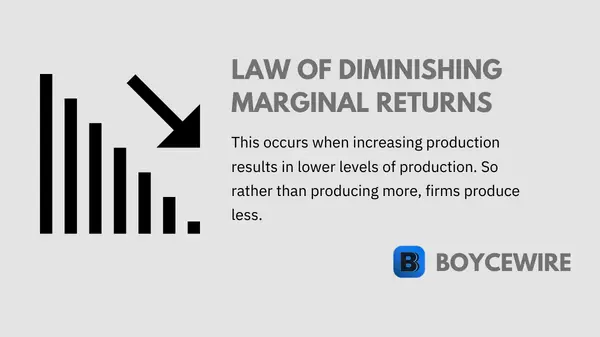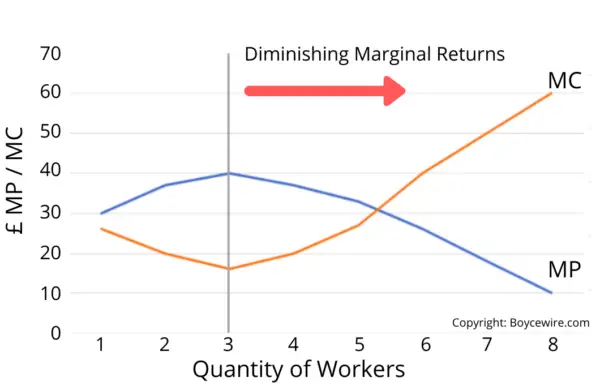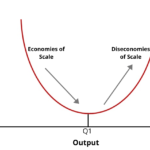Law of Diminishing Marginal Returns: Definition & Examples

Diminishing Marginal Returns Definition
Diminishing Marginal Returns occur when increasing one unit of production, whilst holding other factors constant – results in lower levels of output. In other words, production starts to become less efficient.
For example, a worker may produce 100 units per hour for 40 hours. In the 41st hour, the output of the worker may drop to 90 units per hour. This is known as Diminishing Returns because the output has started to decrease or diminish.
An important aspect of diminishing marginal returns, is that output does not necessarily start to decrease. Instead, output is not increasing at such a high rate as previously. To put it another way – employing another worker does not increase output as much as it did by employing the previous worker. So adding another worker makes the process less efficient.
Key Points
- Diminishing Marginal Returns occur when an extra additional production unit produces a reduced level of output.
- Some of the causes of diminishing marginal returns include: fixed costs, limited demand, negative employee impact, and worse productivity.
- The law of diminishing marginal returns is closely associated with diseconomies of scale – where the business starts to become less efficient due to its size.
Law of Diminishing Marginal Returns
A company may employ an additional factor of production. This may be another machine or another employee, or some other factor. Diminishing Marginal Returns then occurs when these factors start producing fewer goods than previously.
Let us take an example:
- An employee costs $20 to hire per hour
- That first employee produces 2 goods
- A second employee is hired and produces an additional 4 goods
- The Marginal Cost to produce 4 extra goods was the employees wage of $20, so each good cost $5. At this stage, an additional employee is still producing a greater level of output.
- A third employee is hired and produces an additional 4 goods.
- A fourth employee is hired but only produces an additional 2 goods.
- We can see from this example that after 4 employees, the Marginal Returns start to diminish
- We can see from this example that after 4 employees, the Marginal Returns start to diminish. So, after 4 workers, there are Diminishing Returns
Causes of Diminishing Marginal Returns
At a certain point in production, businesses start to become less productive. In economics, this is an important concept as efficiency starts to decrease at this point. Businesses may wish to stop production or re-assess its pricing strategy as the marginal cost increases.
There are many causes of diminishing marginal returns. Examples include:
- Fixed Costs
- Lower levels of Productivity
- Limited Demand
- Negative Impact on Working Environment
- Short-run
1. Fixed Costs
Diminishing Returns can occur when a business needs to purchase new capital equipment or other fixed cost. For example, a manufacturer may create a new factory, but it may produce less than existing factories – therefore creating diminishing returns.
2. Lower levels of Productivity
At a certain point, hiring an additional worker can be counterproductive. For example, 2 staff in a coffee house may be enough. However, a third, fourth, or fifth employee may create a chaotic environment that is inefficient. They may also start talking with each other rather than working on tables.
3. Limited Demand
A firm may hire an additional worker to satisfy demand, but they may not cover the full output that the employee is capable of. For example, an employee may be able to produce 10 units, but there is only demand for 5. Therefore, the employee only produces 5, resulting in diminishing returns. We may see this in local stores which see a low footfall.
4. Negative Impact on Working Environment
On occasion, employing more people can disrupt others. For example, squeezing more workers into the same office may create an uncomfortable atmosphere. Similarly, bringing in a new piece of machinery might create unintended consequences. For instance, it may alter the room temperate, thereby affect the quality of other products.
5. Short Run
The law of Diminishing Marginal Returns can only occur in the short-run. This is because all factors are variable in the long-run. For example, having an additional worker in the cafe may create for a chaotic environment. However, the employees may learn to work more efficiently together and therefore produce better returns in the long-term.
Diminishing Marginal Returns Examples
Example #1 – Farms

Farms are a classic example of Diminishing Marginal Returns, as they have a specific acreage to harvest. Let’s say there are 100 acres and each employee can cover 25 acres each. Only 4 employees are needed, so anything more would bring about Diminishing Returns.
There is also the case for fertiliser use which can help boost growth. Too much fertiliser can start to kill the farms crops, whilst just enough can help increase output.
Example #2 – Education

In Education, students tend to spend roughly 5 to 6 hours in a classroom. Others may spend 2 hours revising every night. However, there is a certain point where students continue to revise but do not digest the information. For example, if student X spends 12 hours straight revising, those last few hours are unlikely to produce any positive results.
At a certain point, we all become bored or disengaged from a topic or subject. After this point, we are driven purely by will power. That is not necessarily the most productive way to learn and will produce Diminishing Marginal Returns in the amount of information we take in.
Example #3 – Coffee House

The Coffee House example shows how too many employees can cause confusion and create inefficiencies. For example, 3 barristers may be working at the coffee shop. They can efficiently serve customers. When another employee is added, there may be communication issues, or they start to get in each other’s way. Two barristers may make the same order without knowing.
To take this example to the extreme; imagine 100 workers crammed into your local coffee shop. As you can imagine, it would be quite chaotic. At a certain point, adding another employee will start to decrease the efficiency of the operation.
Diminishing Marginal Returns Diagram
As we can see from the diagram, at 3 workers, the gap between marginal profit and marginal cost is at its maximum. However, at 4 workers, the marginal cost of producing an additional unit starts to become more expensive. At this point, we start to see diminishing marginal returns.

FAQs
Diminishing Marginal Returns occur when increasing production further results in lower levels of output. In other words, production starts to become less efficient.
Farms are a classic example of Demising Marginal Returns. They have a specific acreage to harvest. Let’s say there are 100 acres and each employee can cover 25 acres each. Only 4 employees are needed, so anything more would bring about Diminishing Returns.
In the same fashion, the use of fertilisers can help boost growth. However, too much can reduce output by killing off the vegetation.
Diminishing returns occur for a number of reasons such as:
1. Fixed costs
2. Less Productive
3. Limited Demand
4. Negative Impact on working environment
5. Short-run Effects
A firm can overcome diminishing marginal returns by finding ways to increase efficiency, such as by improving technology or restructuring production processes. Alternatively, a firm can diversify its product line or expand into new markets to increase overall output.
About Paul
Paul Boyce is an economics editor with over 10 years experience in the industry. Currently working as a consultant within the financial services sector, Paul is the CEO and chief editor of BoyceWire. He has written publications for FEE, the Mises Institute, and many others.

Further Reading
 Diseconomies of Scale: Definition, Types & Examples - It is an economic term that defines the trend for average costs to increase alongside output.
Diseconomies of Scale: Definition, Types & Examples - It is an economic term that defines the trend for average costs to increase alongside output.  Capital Flight: Definition, Causes, Effects & Examples - Capital flight occurs when investors or businesses remove their money from a country.
Capital Flight: Definition, Causes, Effects & Examples - Capital flight occurs when investors or businesses remove their money from a country.  Cash Cow - A cash cow refers to a business or product that generates a steady and significant cash flow with minimal investment…
Cash Cow - A cash cow refers to a business or product that generates a steady and significant cash flow with minimal investment… 